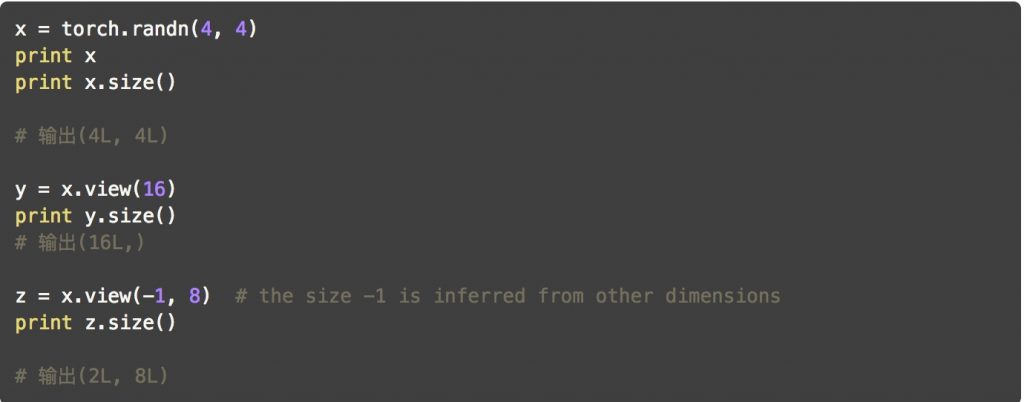我对以下代码片段中的方法view()感到困惑,不知道这个view方法起什么作用。
class Net(nn.Module):
def __init__(self):
super(Net, self).__init__()
self.conv1 = nn.Conv2d(3, 6, 5)
self.pool = nn.MaxPool2d(2,2)
self.conv2 = nn.Conv2d(6, 16, 5)
self.fc1 = nn.Linear(16*5*5, 120)
self.fc2 = nn.Linear(120, 84)
self.fc3 = nn.Linear(84, 10)
def forward(self, x):
x = self.pool(F.relu(self.conv1(x)))
x = self.pool(F.relu(self.conv2(x)))
x = x.view(-1, 16*5*5)
x = F.relu(self.fc1(x))
x = F.relu(self.fc2(x))
x = self.fc3(x)
return x
net = Net()
有困惑问题在下面这行。
x = x.view(-1, 16*5*5)
tensor.view()方法有什么作用?我已经在许多地方看到它的用法,但我无法理解它如何解析它的’参数。
如果我将负值作为参数提供给view()函数会发生什么?例如,如果我调用tensor_variable.view(1, 1, -1)会怎么样?
请举例说明view()功能的主要原理。
最佳解释
view函数旨在reshape张量形状。
假设你有一个张量
import torch
a = torch.range(1, 16)
其中a是一个张量,有16个元素,从1到16(包括在内)。如果你想重塑这个张量使其成为4 x 4张量,那么你可以使用
a = a.view(4, 4)
现在a将是一个4 x 4张量。(注意,重塑后元素的总数需要保持不变。将张量a重新整形为3 x 5张量是不合适的)
参数-1是什么意思?
如果你不知道你想要多少行,但确定列数,那么你可以将行数设置为-1(你可以将它扩展到具有更多维度的张量。只有一个轴值可以是-1)。这是告诉系统Library:给我一个具有这么多列的张量,并计算实现这一点所需的适当行数。
这可以在您上面给出的神经网络代码中看到。在前向功能中的x = self.pool(F.relu(self.conv2(x)))行之后,您将拥有一个16深度的特征图。您必须将其展平以将其提供给全连接的图层。所以告诉pytorch重新塑造你获得的张量,使其具有特定数量的列并让它自己决定行数。
从numpy和pytorch之间的相似性来看,view类似于numpy的reshape函数。
补充解释
让我们举一些例子,从简到难。
-
view方法返回张量与self张量相同的数据(这意味着返回的张量具有相同数量的元素),但具有不同的形状。例如:a = torch.arange(1, 17) # a's shape is (16,) a.view(4, 4) # output below 1 2 3 4 5 6 7 8 9 10 11 12 13 14 15 16 [torch.FloatTensor of size 4x4] a.view(2, 2, 4) # output below (0 ,.,.) = 1 2 3 4 5 6 7 8 (1 ,.,.) = 9 10 11 12 13 14 15 16 [torch.FloatTensor of size 2x2x4] -
假设
-1不是其中一个参数,当将它们相乘时,结果必须等于张量中的元素数。如果您执行:a.view(3, 3),它将引发RuntimeError,因为对于具有16个元素的输入,形状(3 x 3)无效。换句话说:3 x 3不等于16但是9。 -
您可以使用
-1作为传递给函数的参数之一,但只能使用一次。所发生的事情是该方法将自动计算维度。例如,a.view(2, -1, 4)等同于a.view(2, 2, 4)。 [16 /(2 x 4)= 2] -
特别请注意,返回的张量共享相同的数据。如果您相对”view”中进行更改,则需要更改原始张量数据:
b = a.view(4, 4) b[0, 2] = 2 a[2] == 3.0 False -
现在,对于更复杂的用例。文档说每个新的视图维度必须是原始维度的子空间,或者只有跨度d,d + 1,…,d + k满足以下contiguity-like条件,对于所有i = 0,… ,k – 1,stride [i] = stride [i + 1] x size [i + 1]。否则,需要在可以查看张量之前调用
contiguous()。例如:a = torch.rand(5, 4, 3, 2) # size (5, 4, 3, 2) a_t = a.permute(0, 2, 3, 1) # size (5, 3, 2, 4) # The commented line below will raise a RuntimeError, because one dimension # spans across two contiguous subspaces # a_t.view(-1, 4) # instead do: a_t.contiguous().view(-1, 4) # To see why the first one does not work and the second does, # compare a.stride() and a_t.stride() a.stride() # (24, 6, 2, 1) a_t.stride() # (24, 2, 1, 6)请注意,对于
a_t,stride [0]!= stride [1] x size [1],因为24!= 2 x 3

